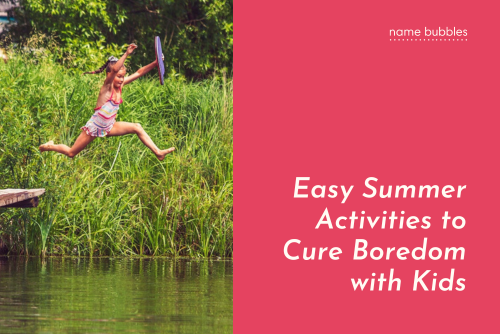6 Earth Day Activities for Kids to Learn About Loving Our Planet
With warmer spring weather, longer, sunnier days, and flowers about to bloom, nature's beauty can not help but be appreciated! Luckily, appreciation for the great outdoors could not come at a more perfect time, with Earth Day just around the corner!
With gorgeous weather and Earth Day on the horizon, this is your time to be inspired by Planet Earth and celebrate Earth Day by following these 6 fun Earth Day activities for kids to help teach your children about loving nature and the great outdoors!
Teach your kids about how seeds and how seeds grow:
This Earth Day activity is perfect for younger kids and helps teach kids about the science behind seed sprouting! All you need are some seeds (we recommend pea or bean seeds for faster growth), paper towels, a clear glass jar, and water. This activity will allow your kiddos to observe what will happen below the surface when a seed is planted and begins to sprout underground as they would in the natural world.
Using the paper towels, smush the seeds into the bottom of the glass jar. Water the paper towels inside the jar, but make sure to avoid over-watering and flooding the glass container. Once you have your jar ready, help your child put the seeds in the paper towel and make sure they can be seen from the outside of the jar.
This science experiment is one of our great Earth Day projects to explain how seeds absorb the water and then begin to grow. Once the seed starts to sprout, have your child observe their jar for slow progress in the seed sprouting.
First, your child will observe the roots that will spring out of the seed. These roots will plant into the paper towel, which mimics how they would plant themselves into the dirt. Then, the roots will continue to grow thing root hairs until a small seedling starts to push its way up towards the top of the glass jar.
Explain to your child how seeds first grow “down” into the soil before growing “up” towards the sun. Growth often starts below the surface before it can be easily observed on Earth! Kids love being able to observe the progress of their seedlings themselves and this is a perfect Earth Day activity for both younger and older kids.
Tip: Use an empty composition notebook as a "plant guide" or "data book" for your child to write their observations in. This will help them remember the seed's growing process and allow them to write and share any unique observations they have made beyond Earth Day. Helping your child write their thoughts and observations in a journal will help your kids celebrate Earth Day even once it’s over and will motivate your child to be excited and interested in learning about science and the natural world even when they are not in the classroom or at school!

Go on a nature walk and press flowers and leaves
Spending time in nature is one of the best ways to appreciate all that the earth has to offer. As a fun way to celebrate Earth Day, consider taking a trip to your nearest park and going for a hike, having a picnic, or just exploring for your Earth Day activities! This is also a great opportunity to teach your kids about the environment through different types of plants and animal habitats.
Walking around the park is the perfect opportunity to take your children on a nature walk. Take note of the different types of trees, flowering plants, and shrubs. If any animals are spotted on your nature walk, write down descriptions of them in a composition notebook and encourage your child to draw a picture that represents the spotted creature.
While you’re on your nature walk, take some time to press flowers or leaves! Be mindful to only collect flowers or leaves from public property and to not damage any foliage in the process.
Once you’re able to collect flowers and leaves, bring your newfound treasures home since these recent outdoor finds provide the perfect opportunity to share a nature-themed craft.
To press flowers, first, find a somewhat heavy book. You don’t want the book's pages to be too thick, or else the flowers will take longer to dry and press. Once you have your book, find those pretty flowers you collected to press!
Flower pressing is a two-person job, so one person should hold the flower open while the other person gently lays the flower between two pages of the book. Depending on the age of your children, you may need to help them handle the delicate flower. Once the flowers are in place, close the book and make sure to put the book in a safe and flat place.
After you have your flowers pressed in the book, put something heavy on top of the book so that the flowers will stay flat while they dry. Leave the flowers for a minimum of two weeks, but we recommend leaving them for at least a month to ensure they are dehydrated. For pressing leaves or shrubbery, follow the same process as if you were pressing a flower.
After the flowers are dry, you can use them in a multitude of ways! If you have younger children, you could use the dry flowers and leaves in sensory play activities or as materials in your children’s future crafts. To engage your child in an Earth Day craft, you can tape the pressed flowers inside a composition book and allow your child to write about their outdoor finds. Creating a flower and leaf guide in a journal is a wonderful way to encourage children to be excited about science and engage in fun Earth Day activities. If your child is interested in alternative Earth Day activities, you can also use the beautiful pressed flowers to decorate your home or even make Earth Day cards and gifts for friends and family!

Plant a bee and butterfly garden
What’s more whimsical than butterflies and bees fluttering around a garden? This Earth Day activity is perfect for kids of all ages. It will teach them about the importance of bees and butterflies in our ecosystem and allow them to celebrate Earth Day when they observe these beautiful pollinators themselves!
Butterflies and bees are pollinators, which means they help transfer pollen from the male parts of flowers to the female parts. This process is essential for plant reproduction, and in recent years, there has been a stiff decline in these much-needed pollinators.
Helping these loveable pollinators is a great way to support Earth Day and keep kids interested in the outdoors. To plant your own bee and butterfly garden, you will need to find a sunny spot in your yard or on your balcony. Once you have found the perfect location, start planting!
Make sure to include a variety of flowers in your garden so that the bees and butterflies have plenty of options for Pollination. Some flowers that attract bees and butterflies are lavender, echinacea, and daisies. In your child’s composition notebook, have them write down the different types of flowers you will have planted along with the types of butterflies and bees that may come visit your future garden!
You can find seeds for these flowers at your local nursery or online. This Earth Day activity does take several steps and will span over several weeks to a month to complete. Once you have planted your garden, sit back and wait for the flowers to bloom! Personalize your garden by having your children decorate signs and labels to remember what each flowering plant is. Once everything is planted, labeled, and starting to grow – sit back, relax and enjoy watching the bees and butterflies flutter around!
Make your own bird feeder
Many birds migrate during the springtime, so this is a perfect opportunity to teach your kids about different types of birds! Having a bird feeder will also entice your kids to want to spend more time outside where they can observe all different kinds of beautiful birds. However, even on rainy or colder days, if you hang up your bird feeder in your backyard or close to a window, you and your kids can still watch the birds up close!
This Earth Day craft is easy and only requires a few materials that you probably already have at home.
To make your bird feeder, you will need:
-A plastic bottle
-Scissors
-Birdseed
-String or yarn
-Peanut butter (optional)
First, use the scissors to cut two holes in the plastic bottle. Make sure to explain to your kids that re-purposing an old plastic bottle is an excellent example of supporting the Earth and supporting a less-waste household. This Earth Day craft may even spark more great ideas for kids' activities using recyclable materials in the future!
Next, thread the string or yarn through the holes, make a loop with the string, tie a knot at the end of the string, and make sure to double-check so that the string is secure.
Now it’s time to fill your bird feeder with birdseed! You can also add a layer of peanut butter to the inside of the bottle. The peanut butter will act as glue and will help keep the birdseed in place and may possibly be more enticing to the birds!
Once your bird feeder is full, find a place to hang it up! We recommend hanging it from a tree branch or a shepherd’s hook.
Once you’ve made your own bird feeder, sit back and have fun watching the birds as they come to eat! Make sure to have your kids draw pictures or write observations of the birds who come to visit the bird feeder. This will allow them to appreciate and remember the birds that come visit your backyard!
Learn about the life cycle of a butterfly!
This activity is perfect for teaching kids about growth and changes in life! The life cycle of butterflies is also a great opportunity to teach kids about metamorphosis and the importance of taking care of our planet Earth.
We recommend reading a book, showing a chart, or even raising butterflies yourself to help demonstrate the life cycle of a butterfly!
If you would like to raise caterpillars into butterflies, you will need to find a butterfly garden or purchase a butterfly kit. These kits are very interactive and will allow your child to first-hand experience the process of a caterpillar growing into a beautiful butterfly. Once you have your butterflies, make sure to release them into the garden or back into Mother Nature.
Regardless of whether or not you decide to use an interactive butterfly garden, you can still encourage your child to take or draw pictures of the different stages of a butterfly and keep observations and notes in their journal so they can remember what they have learned!
For another one of our interactive Earth Day crafts, try out our DIY Coffee Filter Butterfly Project! This at-home craft is super fun and engaging for kids and allows kids to be creative and learn while celebrating Earth Day!
If you try out this adorable craft, make sure to share your creations with us on social media using @namebubbles and #namebubbles!

Start a family recycling bin
Recycling is a great way to reduce your carbon footprint and take care of our planet. It’s also one of the perfect Earth Day activities for kids! They will love sorting the different items and putting them in the right bin. This will also teach your kids how to live a more sustainable and waste-free life which is a great lesson for anyone to learn!
To start, you will need to find a place in your house for the recycling bin and you’ll need an assortment of little bins. We recommend putting the bins in the kitchen or in the garage for easy access.
Once you have found a spot, gather all of your recyclable materials and put them in the little bins. We recommend sorting the items by type (plastic, glass, metal, etc.) so it’s easier to recycle them later. You can even use construction paper and allow your kids to decorate different bin signs to help label the different types of recyclable material.
Each week when it’s time to sort your recyclable materials, this can become an interactive learning experience for you and your family! Have a “recycling night” where everyone in your family can help organize all the materials into different categories before they’re recycled or taken to the recycling plant. This will also help teach your kids which materials can be recycled and which cannot.
Now that the bin is full, it’s time to start recycling! You can take the items to a local recycling center or put them in your city’s recycling bin. This is one of our Earth Day activities for kids that is an easy way to engage your kids about recycling and protecting the environment while also allowing them to explore how easy and fun it can be to recycle used materials.

Conclusion
Whether you decide to recycle, plant a pollinator-friendly garden, or take a nature walk, we hope you are encouraged to spend time outdoors, involve those little hands in loving our planet, and teach your children to celebrate Earth Day! This Earth Day, we encourage you to get outside, get involved in protecting the environment, and teach your children how to love nature.
All the Earth Day activities for kids we shared are easy, interactive, and fun for kids. Most importantly, they are educational and help teach the younger generations how to love our planet! Whether your children are preschoolers, in elementary school, or even older students – these are all great activities to engage in family Earth Day crafts and activities.
If you tried any of these Earth Day activities for kids, share with us on social media! Make sure to tag @namebubbles and use the hashtags #namebubbles and #labeledlife!
Happy Earth Day Name Bubbles family! We’ll see you outside!






